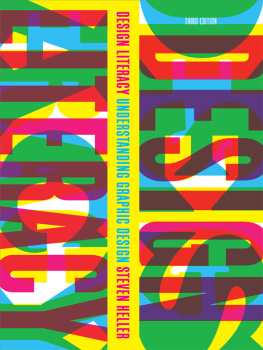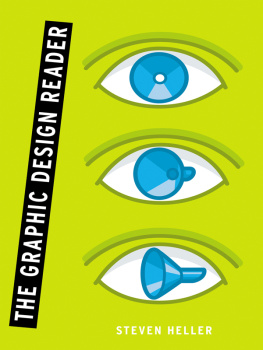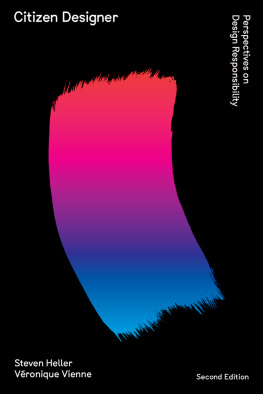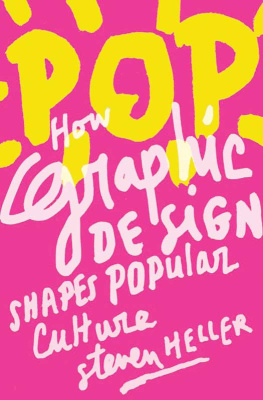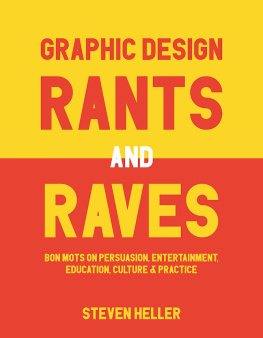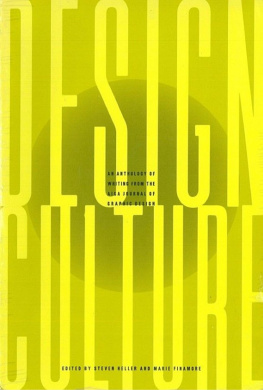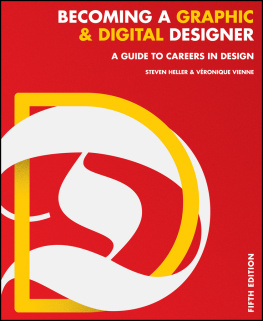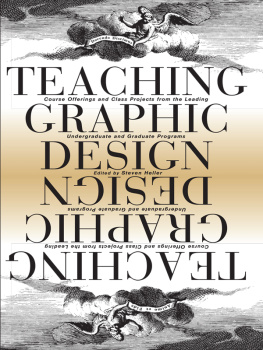Copyright 2014 by Steven Heller
All Rights Reserved. Copyright under Berne Copyright Convention, Universal Copyright Convention, and Pan American Copyright Convention. No part of this book may be reproduced, stored in a retrieval system, or transmitted in any form, or by any means, electronic, mechanical, photocopying, recording or otherwise, without the express written consent of the publisher, except in the case of brief excerpts in critical reviews or articles. All inquiries should be addressed to Allworth Press, 307 West 36th Street, 11th Floor, New York, NY 10018.
Allworth Press books may be purchased in bulk at special discounts for sales promotion, corporate gifts, fund-raising, or educational purposes. Special editions can also be created to specifications. For details, contact the Special Sales Department, Allworth Press, 307 West 36th Street, 11th Floor, New York, NY 10018 or .
17 16 15 14 13 5 4 3 2 1
Published by Allworth Press, an imprint of Skyhorse Publishing, Inc.
307 West 36th Street, 11th Floor, New York, NY 10018.
Copublished with the School of Visual Arts
Allworth Press is a registered trademark of Skyhorse Publishing, Inc., a Delaware corporation.
www.allworth.com
Cover and interior design by Anderson Newton Design
Page composition/typography by Anderson Newton Design
Library of Congress Cataloging-in-Publication Data is available on file.
ISBN: 978-1-62153-404-4
eISBN: 978-1-62153-413-6
Printed in China
DEDICATION
James H. Fraser and William Drenttel
They will be missed so very much.
Contents
THOMAS THEODORE HEINE
JOHN HEARTFIELD
TOMI UNGERER
SEYMOUR CHWAST, DESIGNER
ROBBIE CONAL
PAUL RAND
EDWARD GOREY
ALEXEY BRODOVITCH
ALVIN LUSTIG
FRANK ZACHARY
ALEXANDER LIBERMAN
WILL BURTIN
HERB LUBALIN
SEYMOUR CHWAST, MILTON GLASER, REYNOLD RUFFINS, EDWARD SOREL
KEN DEARDORF AND DUGALD STERMER
RUDY VANDERLANS AND ZUZANA LICKO
FRANOISE MOULY AND ART SPIEGELMAN
DAVID CARSON
A.M. CASSANDRE
OSWALD COOPER
JOOST SWARTE
TEAL TRIGGS, LIZ MCQUISTON, AND SIAN COOK
BARRY DECK
JONATHAN BARNBROOK
FORTUNATO DEPERO
ALVIN LUSTIG
MERLE ARMITAGE
LESTER BEALL, BROWNJOHN CHERMAYEFF GEISMAR, HERB LUBALIN, GENE FEDERICO
LOU DORFSMAN
GENE FEDERICO
SAUL BASS
LADISLAV SUTNAR
PAUL BACON
VICTOR MOSCOSO
PAULA SCHER
ROBERT MASSIN
WILHELM DEFFKE
E. MCKNIGHT KAUFFER
RUDOLPH DE HARAK
MILTON GLASER
PAUL RAND
PABLO FERRO
M&CO.
PAUL DAVIS
PAULA SCHER
LADISLAV SUTNAR
QUENTIN FIORE
MASSIMO VIGNELLI
MASSIMO VIGNELLI AND ASSOCIATES
STEFAN SAGMEISTER
W. A. DWIGGINS
PAOLO GARRETTO
SEYMOUR CHWAST
LOUISE FILI
CHARLES SPENCER ANDERSON
LUCIAN BERNHARD
ALEX STEINWEISS
R. CRUMB AND BOB CATO
Acknowledgments
T here would be no Design Literacy if not for Tad Crawford, publisher of Allworth Press. His ongoing enthusiasm and support for my work, specifically and design writing and research in general, is simply invaluable. His contributions are not heralded enough.
Thanks to Gail Anderson, designer of this edition, my colleague in books and teaching, who is not only a great interpreter of my raw material, but a stunning author in her own right (write).
Having Rick Poynor write the foreword for this book is the first time since one of my earliest books that Ive had a voice other than mine introduce a book. I have great admiration and warmth for Mr. Poynor and his work. Thank you.
James Victore was the original designer for Design Literacy and most of the 30-plus Allworth books Ive worked on. I am indebted to him for creating graphic identities that continue to give me great pleasure to have and hold.
Appreciation to Thornwell May, our editor at Skyhorse/Allworth, for seeing this revision through the intricate production process.
I owe a great deal to the good offices of David Rhodes, President of the School of Visual Arts, who has long generously supported my projects and Allworth Press. Thanks also to Anthony Rhodes, Executive Vice President of SVA.
I am grateful to many people who have given me inspiration and raw material to work with. In no particular order they are: Paul Rand, Lita Talarico, Mirko Ilic, Seymour Chwast, Paula Scher, Radislav Sutnar, John Walters, Martin Fox, Massimo Vignelli, George Lois, Robbie Conal, Edward Gorey, Stefan Sagmeister, Michael Bierut, Jessica Helfand, Christoph Niemann, Cathy Leff, Marshall Arisman, Tom Bodkin, Deborah Auer, John Macleod, Hans Reichert, Lucas Dietrich, Laurence King, Eric Himmel, Elaine Lustig Cohen, Allan Rapp, and scores of others living and dead.
Most of all, I thank my wife, Louise Fili, for being such a bright and elegant light in my life and Nicolas Heller, our son, who makes me proud every day of my life.
SH
Foreword
BY RICK POYNOR
F or many years, Steven Heller has been the most prolific and committed writer covering the field of graphic design. He may also be its most knowledgeable and wide-ranging author. But even if we qualify that, as a precaution, and just say one of the most knowledgeable, there can be no question that he is the most generous when it comes to sharing his vast wealth of knowledge with readers.
I have a running gag with him about which of his scores of books are currently in my Heller top ten. Design Literacy went in immediately on its first publication in 1997 and there its successors remain. I regard it as one of his most valuable, satisfying, and enduring publications. Heller supplemented the original edition with Design Literacy (Continued) and then he blended the two together in the second edition of Design Literacy. With this volume, he once again retunes the line-up of essays, and if the book keeps attracting new readers, there is no reason why it shouldnt continue to evolve. One thing this signals is that Heller is not at all precious. The book, like the man, is restless, curious, a buzzing zone of energy.
For anyonedesigner or notwho wants an understanding of what graphic design is, or has been, Design Literacy offers an excellent introduction. Unified histories of the subject tend to be big, worthy, and ponderous. Their fate is often to be dipped into for reference rather than read from end to end. Despite its thematic structure, Design Literacy is a book devised to be absorbed in any order and savored at whim. As with many essay collections, part of the pleasure comes from bouncing serendipitously from one revelation to the next. These short- to medium-length pieces are loaded with information and insight. Hellers subject is the everyday graphic paraphernalia that surrounds us, and he handles his task with urbanity, wit, and a tender concern I suggest we can only call love.
Its strange there arent more books about graphic design like this, but there really arent. Heller proves here that graphic communication can be a readerly subject like any other. Can we become properly design literate without a broad working knowledge of the kinds of material he surveys so adeptly? I think thats unlikely. We can only develop design literacy by informed looking, and this juicy collection reaffirms Heller as one of our most attentive and fluent guides to the territory.
Design Literacy Third Edition
D esign Literacy was originally called Object Lessons: Understanding Graphic Design, but fortunately I was made to realize that not only was this title too imprecise, it was too cute. Conversely, Design Literacy was like a call to arms, a manifesto of sortsI want my DESIGN LITERACY!!! (apologies to MTV). Since discourse about verbal, visual, and cultural literacy were in the air around the time of publication in 1997, and design literacy was a subset of that, the title tapped into the zeitgeist and continues to have resonance. Arguably, the title just might account for the books success.

